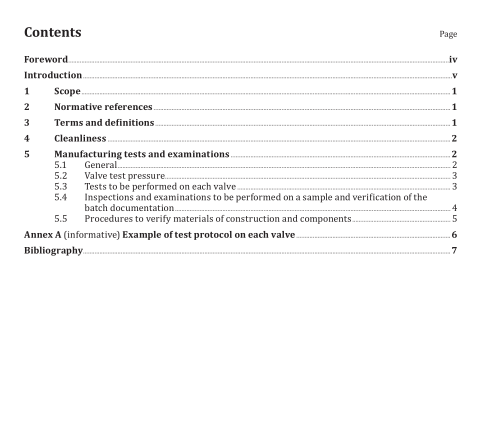ISO 14246:2022 pdf download.Gas cylinders — Cylinder valves — Manufacturing tests and examinations
4 Cleanliness
The manufacturing process including all tests shall be such that the valves are supplied clean and dry to meet the requirements of the intended service, e.g. see ISO 15001 for medical applications.
Gas wetted components of valves for oxygen and other oxidizing gases (see ISO 10156) shall be clean of oil and grease so that the level of hydrocarbon contamination is not greater than 220 mg/m 2 . In addition, components shall be free from particles of a size larger than 200 µm. This shall be verified by an appropriate method, e.g. as given in ISO 15001.
Consideration shall be given to minimize the introduction of particles and the risk of contamination during the assembly process.
5 Manufacturing tests and examinations
5.1 General
Tests and examinations performed to demonstrate compliance with this document shall be conducted using instruments calibrated before being put into service and thereafter according to an established programme.
Manufacturing tests and examinations, which are further specified in 5.3, 5.4 and 5.5, shall include:
— tests to be performed on each valve;
— inspections and examinations to be performed on a sample, and verification of the batch documentation;
— procedures to verify materials of construction and components.
The respective results shall be recorded.
5.2 Valve test pressure
Testing shall be conducted at p vt as given in Table 1.
5.3 Tests to be performed on each valve
Each valve shall be subjected to both internal leak tightness and external leak tightness testing prior to dispatch.
For internal leak tightness, the valve shall be pressurized from the valve inlet gas passage.
For external leak tightness, the valve in open position shall be pressurized from the valve inlet gas passage with the valve outlet connection sealed or pressurized from the valve outlet connection with the valve inlet connection sealed. The external leak tightness of valves fitted with accessories which form the pressure envelope, e.g. pressure relief devices and pressure gauges, shall be determined with these accessories in place.
For specific designs where the external sealing system is independent of the position of the valve operating mechanism (open or closed), the external leak tightness test may be replaced by an alternative test with the valve in closed position and pressurized from the valve outlet connection. In this case the leak tightness of any components located upstream of the seat shall be tested separately, e.g. as part of the internal leak tightness test.
EXAMPLE O-ring gland seal valve (see ISO 10297:2014, Figure 3).
In addition, the presence of a through passage shall be verified.
Leak tightness tests shall be performed at ambient temperature (usually between 15 °C and 30 °C).
Valves shall be closed with the closing torque specified by the manufacturer but not exceeding the endurance torque at start, T e,start , as used during type testing in accordance with ISO 10297.
The internal leakage rate shall not exceed 6 cm 3 /h.
The total external leakage (typically comprising that from the external valve sealing system plus, for example, PRD, RPV, pressure indicating devices and pressure regulating or reduction system) shall not exceed 6 cm 3 /h for a cylinder valve or main valve or 12 cm 3 /h for a VIPR. For pure or toxic gases, lower leakage rates may be agreed between manufacturer and customer.
NOTE 1 For electronic applications, leakage rates are typically 1·10 −7 He mbar·l/s. Additionally, an extra tightness test to measure the value of leakage into the valve under vacuum may be agreed between manufacturer and customer.
These tests are usually conducted with oil free dry air or nitrogen but other suitable test gases may be used. An example of a test protocol is given in Annex A. Other qualified or accepted methods that conform to this clause may also be used.
NOTE 2 Additional testing can be required for valves with special features, e.g. residual pressure valves or VIPRs.
5.4 Inspections and examinations to be performed on a sample and verification of the batch documentation Inspections and examinations shall be performed on a sample. In addition, a verification of the batch documentation shall be carried out. The sampling plan, the sequence and the detailed content of all these procedures shall be specified in the manufacturer’s quality assurance system.ISO 14246 pdf download.ISO 14246:2022 pdf download
